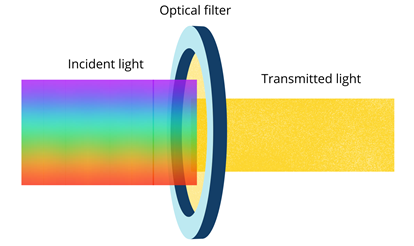Harnessing the properties of light to make useful devices has advanced sensing and spectroscopic technology rapidly. The abundance of sensors and detectors has made the world a place that is being monitored constantly, allowing technology to better comprehend and interact with the surroundings.

Image Credit: emu_melo/Shutterstock.com
One of the primary technologies supporting this expansion is photonics, which makes it easier to create and market inexpensive, small, and reliable optical sensors and devices.
Optical filters play an important role in developing efficient light-based technology.
Fundamentally, all optical sensors and detectors work similarly. As shown in figure 1, the target sample is illuminated by a light source. Light properties such as absorption, transmission, reflection, or light-matter interactions resulting in fluorescence or scattering are activated when the light interacts with the sample. A detector collects the light that has traversed the sample and a spectrum is produced to be analyzed.

Figure 1. Typical experimental schematic for optical sensing. Image Credit: Ilamaran Sivarajah
An optical filter is typically a device dependent on the incident light’s wavelength or frequency. There are other specialized filters where the dependency is on polarization or spatial distribution, or some constant attenuation level is provided.
Passive optical elements composed of substrates make up optical filters. The coatings give the substrate the ability to reflect, transmit, or absorb light depending on its wavelength by altering its medium's refractive index.
Types of Optical Filters
There are many different types of optical filters that have been developed to meet specific requirements demanded by particular applications. Some examples are:
Absorption Filters
Both organic and inorganic materials are used to make the coatings on absorbent filters. These components block unwanted wavelengths while transmitting the target wavelength, as shown in figure 2. For example, a semiconductor's inherent short-wavelength absorption or extrinsic absorption brought on by ionic impurities can be taken advantage of to filter only the wavelengths needed.

Figure 2. Diagram showing how an absorption filter allows only a particular wavelength of light to pass through. Image Credit: Ilamaran Sivarajah
Absorption filters are the most commonly used optical filters in experiments such as gas sensing or molecular spectroscopy, where the objective is to analyze the existence of a particular molecule by shining the exact wavelengths on the sample.
Interference Filters
Different types of optical filters depend on the interference of light combined with wavelength-dependent phase shifts. These filters, also known as interference filters, show wavelength-dependent transmission and reflection.
Dielectric coatings are used in a significant class of interference-based filters. These coatings are employed in polarizing and non-polarizing beam splitters, thin-film polarizers, and dielectric and dichroic mirrors.
Optical Bragg gratings also serve the same purpose as an interference filter. The same physical theory underlies volume Bragg gratings, fiber Bragg gratings, and other optical Bragg gratings. There are gradient-index filters, also known as rugate filters, in addition to step-index structures.
Etalons, arrayed waveguide gratings, and Fabry-Pérot interferometers are likewise based on interference phenomena; however, they occasionally take advantage of somewhat bigger path length variations than monolithic devices.
All the variations of interference filters mentioned above are heavily used in atomic physics experiments. When specific transitions in alkali or alkaline earth atoms are excited, optical filters are placed along the beam path to selectively interrogate the desired energy levels.
Notch Filters
Notch filters, also known as band-stop filters, are built to block a portion of the frequency spectrum. All other frequency light is free to propagate through the filter. Since they can be used in interference applications, notch filters are primarily used for applications requiring the integration of two or more signals. Raman spectroscopic applications where very weak frequency signals are detected benefit greatly from notch filters.
Shortpass and Longpass Filters
Shortpass filters are made to transmit wavelengths that fall below a predetermined limit specified by the optical coating. All other wavelengths are blocked. To transmit wavelengths above a certain target wavelength determined by the optical coating and substrate, longpass filters are used. Wavelengths below the set value are blocked beyond the filter.
These kinds of optical filters are frequently used in filtration applications as well as to limit higher parts of a broad spectrum. Chemical analysis systems and fluorescence spectroscopy are some examples of typical use cases.
Bandpass Filters
Bandpass filters block all frequencies except for a narrow range, in contrast to notch filters. Combining shortpass and longpass filters, they exclude any wavelengths that are either too short or too long. By altering the layers of the filters, this cutoff range can be made wider or narrower.
Tunable Filters
While the majority of optical filter types have fixed optical properties, some are tunable, meaning that their optical properties can be actively changed. For example, by changing the length of the optical resonator with a piezo-controlled mirror, the resonances can be modulated.
In this manner, the optical transmission peaks can be adjusted. In etalons, the transmission peaks can be changed by simply tilting them. Tunable filters are important cogs when analyzing a sample with a tunable laser to identify unique features at different wavelengths.
Outlook
Optical filters are an important component in the chain of devices that make up an optical sensing or spectroscopic setup. Advancements in research and development in building new and high-performing optical filters are making remarkable contributions to environmental sensing, space exploration, virtual reality and many other industrial manufacturing processes.
References and Further Reading
IRIDIAN-Spectral Technologies. Clear the Air: New Optical Filters for Sensors and Detectors. Optical Filters for Sensors and Detectors [Online] Iridian.CA. Available at: https://www.iridian.ca/learning_center/optical-filters-for-sensors-and-detectors-dup/
Pust, O. (2021). Optical Filters – Technology and Applications. In Portable Spectroscopy and Spectrometry (eds R. Crocombe, P. Leary and B. Kammrath). https://doi.org/10.1002/9781119636489.ch7
Mukhopadhyay, N., Saha, A. & Bhattacharya, K. Design of a narrow band-pass birefringent filter for visible range. Pramana - J Phys 95, 142 (2021). https://doi.org/10.1007/s12043-021-02175-0
Disclaimer: The views expressed here are those of the author expressed in their private capacity and do not necessarily represent the views of AZoM.com Limited T/A AZoNetwork the owner and operator of this website. This disclaimer forms part of the Terms and conditions of use of this website.